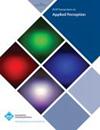Affordance Judgments in HMD-Based Virtual Environments: Stepping over a Pole and Stepping off a Ledge
IF 1.9
4区 计算机科学
Q3 COMPUTER SCIENCE, SOFTWARE ENGINEERING
引用次数: 38
Abstract
People judge what they can and cannot do all the time when acting in the physical world. Can I step over that fence or do I need to duck under it? Can I step off of that ledge or do I need to climb off of it? These qualities of the environment that people perceive that allow them to act are called affordances. This article compares people’s judgments of affordances on two tasks in both the real world and in virtual environments presented with head-mounted displays. The two tasks were stepping over or ducking under a pole, and stepping straight off of a ledge. Comparisons between the real world and virtual environments are important because they allow us to evaluate the fidelity of virtual environments. Another reason is that virtual environment technologies enable precise control of the myriad perceptual cues at work in the physical world and deepen our understanding of how people use vision to decide how to act. In the experiments presented here, the presence or absence of a self-avatar—an animated graphical representation of a person embedded in the virtual environment—was a central factor. Another important factor was the presence or absence of action, that is, whether people performed the task or reported that they could or could not perform the task. The results show that animated self-avatars provide critical information for people deciding what they can and cannot do in virtual environments, and that action is significant in people’s affordance judgments.基于hmd的虚拟环境中的能力判断:跨过杆子和走下窗台
在现实世界中,人们总是在判断自己能做什么,不能做什么。我能跨过那道篱笆吗,还是得从下面钻过去?我能走下那个壁架吗,还是需要爬下去?人们感知到的允许他们采取行动的环境的这些品质被称为可得性。本文比较了人们在现实世界和头戴式显示器呈现的虚拟环境中对两项任务的可视性判断。这两项任务是跨过或钻过一根杆子,以及直接从窗台上走下来。真实世界和虚拟环境之间的比较很重要,因为它们使我们能够评估虚拟环境的保真度。另一个原因是,虚拟环境技术能够精确控制物理世界中无数的感知线索,并加深我们对人们如何利用视觉来决定如何行动的理解。在这里展示的实验中,自我形象的存在与否是一个核心因素——一个嵌入在虚拟环境中的人的动画图形表示。另一个重要的因素是行动的存在与否,也就是说,人们是否执行任务或报告他们能或不能执行任务。结果表明,动画的自我形象为人们决定他们在虚拟环境中能做什么和不能做什么提供了关键信息,而这种行为在人们的能力判断中具有重要意义。
本文章由计算机程序翻译,如有差异,请以英文原文为准。
求助全文
约1分钟内获得全文
求助全文
来源期刊

ACM Transactions on Applied Perception
工程技术-计算机:软件工程
CiteScore
3.70
自引率
0.00%
发文量
22
审稿时长
12 months
期刊介绍:
ACM Transactions on Applied Perception (TAP) aims to strengthen the synergy between computer science and psychology/perception by publishing top quality papers that help to unify research in these fields.
The journal publishes inter-disciplinary research of significant and lasting value in any topic area that spans both Computer Science and Perceptual Psychology. All papers must incorporate both perceptual and computer science components.
 求助内容:
求助内容: 应助结果提醒方式:
应助结果提醒方式:


